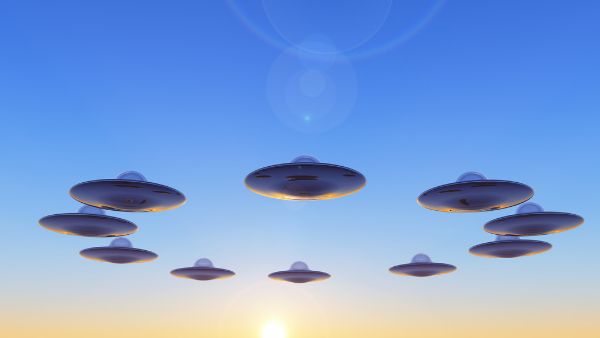
Or maybe the better question would be, “Is the name change from UFO to UAP going to stick? Will UAPs replace UFOs in pop culture?”
Because it’s not like we’re talking about different things. Just the terms and acronyms to describe it aren’t the same anymore. But if there’s no real difference, why change it at all? Let’s start by taking a look at when each came into our vernacular. Maybe we’ll find the answer there.
UFO and UAP Defined
We’re all well aware that UFO stands for “unidentified flying object.” That term has been around for decades, even though UFO sightings have been around for centuries. But it was the “mysterious flying disc” outbreak of 1947 that led to people calling them UFOs. Basically.
At first, they called them flying saucers. The most infamous of such incidents was the Roswell crash in July 1947. But the sightings really all started when private pilot Kenneth Arnold reported spotting nine shiny unidentified flying objects flying at high speeds past Mount Rainier on June 24, 1947.
But as I mentioned, they weren’t called UFOs then. Lexico cites that “according to the Oxford English Dictionary, the term ‘unidentified flying object’ goes back at least to the 1950s: it is recorded in 1953, in a book by the US aviator and writer Donald Keyhoe.”
However, UFO is how we’ve known them ever since. Or we did, until the release of the UFO report in 2021, which was titled the “Preliminary Assessment: Unidentified Aerial Phenomena” report. So I guess it would be more apt to call it the UAP report. (Except that kind of shows people are reluctant to embrace the new term because I rarely see anyone referring to it that way.)
The report compiled the results of the Unidentified Aerial Phenomena Task Force (UAPTF), which was assembled to evaluate “a range of information on UAP described in U.S. military and IC reporting.”
As Smithsonian Magazine pointed out, the report “never even mentioned the possibility of an extraterrestrial origin for the sighted objects,” but did acknowledge UAPs are real —but the “U” is key. Whatever the “aerial phenomenon” is, it’s simply “unidentified.” It could be extraterrestrial or it could be as yet unidentified advanced technology another nation here on Earth is employing to spy on us or something.
Out with UFO, in with UAP
But why the name change? It’s not the public, but the government driving it. As The Washington Post reported in 2019, officials prefer UAP.
Per a quote from Joseph Gradisher, spokesman for the deputy chief of naval operations for information warfare, “The Navy designates the objects contained in these videos as unidentified aerial phenomena. The ‘Unidentified Aerial Phenomena’terminology is used because it provides the basic descriptor for the sightings/observations of unauthorized/unidentified aircraft/objects that have been observed entering/operating in the airspace of various military-controlled training ranges.”
The videos Gradisher referred to included three that the Navy released that showed pilots encountering “mysterious objects” that moved “in ways that baffled experts.” They released two videos in 2017, and a third in 2018. All of which sparked the UFO-loving public’s interest because (a) they weren’t caught on just any video, but by the military, and (b) the videos contained audio, so we heard the pilots’ genuine reactions of befuddlement.
But does UAP sum up the situation any better than UFO? Or is the terminology an attempt to dispel the stigma surrounding UFO sightings? Which, as the UFO report alluded to, often discourages observers (that are enlisted in the military) from making reports for fear of facing ridicule or worse.
I don’t know. I grew up with “UFO” so that’s what I’m sticking with. What about you?
Check-In
Do you think UAP will catch on and replace UFO, or do you think UFOs are too embedded in our terminology now?
Courtney Mroch is a globe-trotting restless spirit who’s both possessed by wanderlust and the spirit of adventure, and obsessed with true crime, horror, the paranormal, and weird days. Perhaps it has something to do with her genes? She is related to occult royalty, after all. Marie Laveau, the famous Voodoo practitioner of New Orleans, is one of her ancestors. (Yes, really! As explained here.) That could also explain her infatuation with skeletons.
Speaking of mystical, to learn how Courtney channeled her battle with cancer to conjure up this site, check out HJ’s Origin Story.
